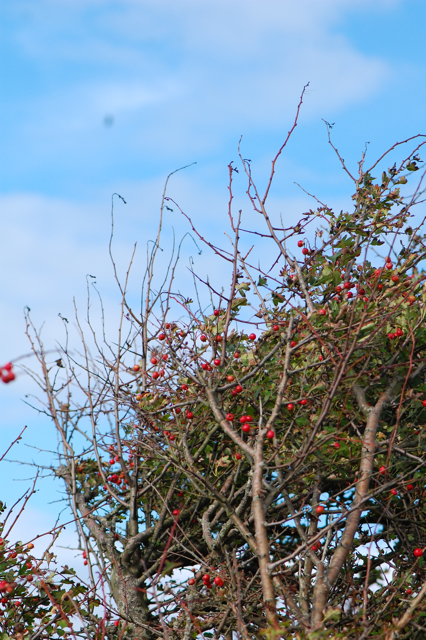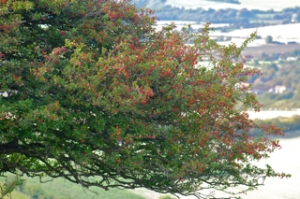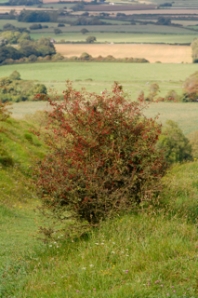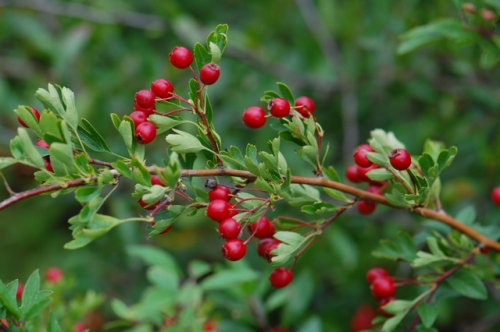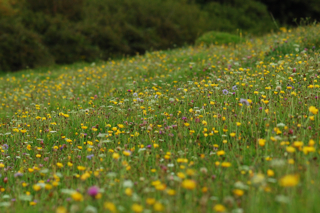Firstly, apologies for not having posted the final cream recipe yet, I ran out of time before Christmas and have been having a little holiday from the computer so it will be with you in the New Year instead.
However as 2011 draws to a close, I would like to take a few moments to look back over the Hawthorn trees which I have been observing throughout the year as part of The Tree Year project. Inspired by the UN’s announcement that 2011 would be the International Year of Forests it encouraged people to pick a tree to observe closely for one year and record some of their findings in whatever way seemed appropriate to them.
I followed these trees which sit atop the Sussex Downs from Winter to Summer and back again, observing not only their individual transformations, but the way they have been shaped by their landscape and by the myriad influences of humans and nature.
For many years I have appreciated the Hawthorn as a fantastic source of medicine and food, not just for humans but for wildlife as well. This project gave me the opportunity to learn more about some of its other facets however and the more I learnt, the more I appreciated its story as that of a true survivor. It thrives in many environments, from cities and gardens to woodland edges, hedgerows and open grassland and it flourishes where other trees could not. The Downs themselves would once have been covered in woodland in all but the most exposed sites but centuries of animal grazing have ensured the trees have not returned. Only the hardiest survive atop these windswept and rain blasted escarpments with their shallow, chalky soil. And they are mainly gorse and hawthorn.
Here in the UK, the eighteenth and nineteenth centuries saw the privatisation of huge amounts of open fields and common land and the removal of access rights of local people through the Enclosure Acts. This saw the planting of miles of Hawthorn hedging throughout the country as hawthorn grows quickly and densely and has sharp thorns – the perfect way to keep people out. This rapid growth gave rise to one of Hawthorn’s old common names, Quickthorn. I often think that perhaps one of the only good things to come out of such a travesty was the Hawthorn hedges which are now such a distinctive and cherished part of our countryside and support such a wide variety of wildlife.
The hawthorn is home to up to 300 different insects and provides food and shelter for many birds. Blackbirds, greenfinches, yellowhammers, robins and wrens all make use of it along with migrant birds like redwings and fieldfares. They spread seed through their droppings making this a mutually beneficial arrangement. Small mammals like voles and wood mice also eat the fallen berries and seek shelter amongst the dense growth of hawthorn branches.
Whilst I love the hedges, Hawthorns are by far the most beautiful when allowed to grow into their full splendour as small trees. They will grow well in most soil types, though they need some sun, as their root system is not too extensive and doesn’t require large amounts of nutrients. They are often seen standing alone on hilltops, each one a unique individual having been shaped by natural forces. In folk mythology it was thought that these lone Hawthorns were inhabited by faeries and Hawthorn is still considered one of the faery trees to this day.
It is used as a rootstock for grafting pears and medlars and the wood was apparently one of those preferred by the Druids for making runes. A fascinating fact (which I am sure you will all find very useful) is that some myths claim hawthorn wood to be the best for staking vampires! I wonder if this refers to the long association with qualities of protection, part of which must come from all the many species it shelters and provides uses for.
It is a tree that looks beautiful in each of its manifestations throughout the changing seasons. The small buds emerging early in the year give way to tender green leaves which are delicious in salads before they toughen up later in the year.
The blossom has equally fantastic medicinal properties as the berries and the two preparations are often used together by herbalists. You can read my accounts of some of the medicinal benefits of Hawthorn here and here.
The blossom can be used to make teas, tinctures, herbal honeys, elixirs, flower remedies or to sprinkle on salads. Some people find the smell offensive but others, including myself, find its sweet headiness quite pleasant.
The oldest Hawthorn in the country is in a village in Norfolk and is thought to be about 700 years old! I would very much like to take a little trip to visit it this coming year. There is said to be one more than twice as old again in France, though apparently this hasn’t been verified.
The summer hawthorn is all green fullness and abundance. I often wonder how the leaves stay on in such windy conditions!
After the blossom dies back, small green berries begin to form which ripen into the wonderful red fruits we so associate with late summer and autumn. These can be made into all sorts of delicious syrups and elixirs as well as being used for tinctures and decoctions. You can read about my Hawthorn syrup here.
Hawthorn has a use for every season; food, medicine and wildlife habitat, it also keeps us warm in the winter months as its hard, dense wood burns hot without being too smoky.
The latin name, Crataegus, comes from the Greek word for strong. Whilst this is thought to reflect the qualities of the wood, I suspect it may actually refer to the nature of the tree itself which is resilient, tough, hardy and above all abundant and unfailingly generous.
Like many of the plants we consider weeds and many of our wilier animal friends like crows and foxes, the hawthorn has only survived and flourished in a changing habitat due to its ability to adapt.
I look forward to many more years of knowing, appreciating and working with this remarkable plant.





























